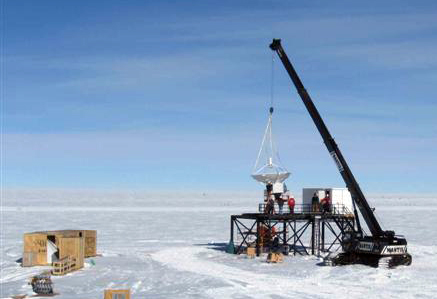Keeping connectedNew ground station at South Pole to help maintain communicationsPosted April 10, 2009
A new satellite communications system at South Pole Station South Pole Station currently has about 9.5 hours of satellite coverage, during which only about six hours are available for high-speed data transmission, mainly for large astrophysical experiments. About 120 gigabytes of data move during this timeframe, at transmission rates of up to 150 megabits per second — more than 10,000 times faster than the 14.4 kilobits per second of modems from not too long ago. Since 1998, the U.S. Antarctic Program (USAP) More Information
Just last October, engineers decommissioned another aging satellite, Marisat-F2 The original South Pole TDRS Relay satellite ground station (SPTR-1, pronounced “spitter one”) uses a fixed-point antenna and an electronics suite incompatible with the rest of NASA’s TDRS satellites and ground station network. When TDRS F1 fails, the SPTR-1 system will become obsolete. Enter SPTR-2, a full-motion, 4-meter satellite dish housed on a new elevated platform under a radome for shelter. The full-motion capability of SPTR-2 allows it to track satellites as they rise briefly above the South Pole horizon. The ability to point the antenna not only extends the availability of the TDRS F1 satellite over that of the SPTR-1 fixed antenna, but it also gives SPTR-2 the ability to turn to other satellites as they rise at different positions on the horizon. The National Science Foundation (NSF) But there’s a catch. These other satellites have many other users, meaning South Pole will have to share communication time and space with the Hubble Space Telescope, Space Shuttle Changes in TDRS satellite service will mean changes in the way science data and personnel interact with their colleagues in the United States and around the world. This represents another evolution in South Pole station operations, one of the most unique and challenging places to live and work on the planet. |



For USAP Participants |
For The Public |
For Researchers and EducatorsContact UsU.S. National Science FoundationOffice of Polar Programs Geosciences Directorate 2415 Eisenhower Avenue, Suite W7100 Alexandria, VA 22314 Sign up for the NSF Office of Polar Programs newsletter and events. Feedback Form |


